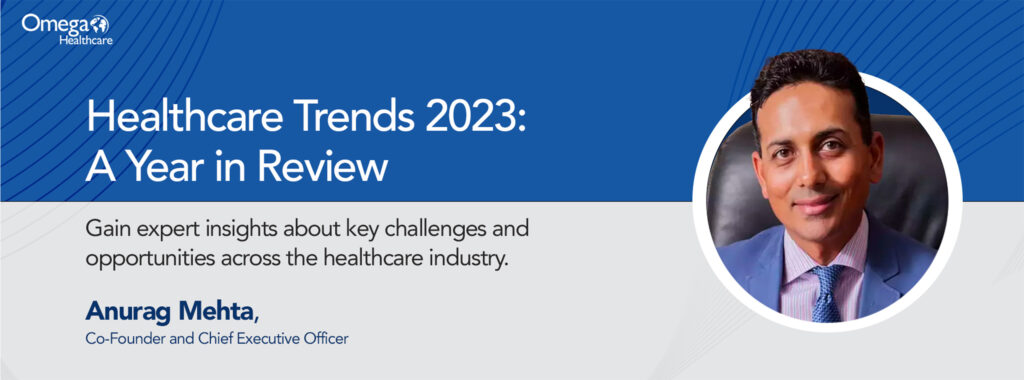What healthcare leaders and executives need to know
Anurag Mehta, Co-founder and Chief Executive Officer, Omega Healthcare
Healthcare leaders across all sectors are still struggling after the COVID-19 pandemic. Organizations have been navigating challenging waters, from labor shortages to inflation to supply chain interruptions and plummeting consumer trust. Below are three key healthcare challenges that have monopolized the headlines in 2023.
Staffing challenges in healthcare
Staff shortages are among the most significant healthcare challenges, showing little sign of abatement. The “great resignation” has hit nearly every sector of healthcare. Spurred on by the pandemic, many employees retired or quit their jobs for fear of catching the virus. It is estimated that the US will need 1.2 million more nurses by 2030, enough to replace all the baby boom RNs who will retire over the next decade.[1] Although some healthcare organizations have called employees back to the office, many companies have not, opening up more remote opportunities for employees who don’t want to give up their work-from-home gigs. They can look for the most favorable remote positions with the best benefits and the highest wages; they’re no longer limited to local opportunities. This has increased the cost of recruiting, hiring, and onboarding new employees and has been a primary instigator of rising expenses across the industry.
Another way the pandemic has influenced the staffing shortage is that it exacerbated clinician burnout, causing many to reevaluate their career goals and prioritize work-life balance over traditional goals like higher wages and advancement opportunities. The mental health impact of the pandemic, including seeing loved ones lose their lives and others lose their livelihoods, has also driven many workers to seek less stressful, more fulfilling work at companies that prioritize work-life balance.
Besides the direct impact on patient care, labor shortages have caused backlogs in typically manual processes associated with an organization’s revenue cycle. It has caused a lack of internal expertise as more experienced workers leave and are replaced by new, inexperienced staff. This ongoing healthcare challenge has put increased pressure on existing staff, which can increase errors, delays in care, delays in clinical trials, and delays in reimbursement.
Expansion of non-traditional providers
With the proliferation of high-deductible health plans, consumers are responsible for more healthcare costs. In light of this, they are seeking more cost-effective options for getting care. Today, there are more options than ever, with retail clinics (CVS Minute Clinics, Walmart Health), walk-in urgent care centers, telehealth services (Amazon Clinic), and pharmacy clinics readily available. The introduction of these alternative care providers has increased competition and made continuity of care more challenging. Patient data is now spread across multiple organizations, making it difficult for healthcare organizations to access a complete view of the patient’s history. This type of fragmented care is one of the biggest challenges in healthcare because it can impact outcomes and drive costs higher through duplication of tests and misaligned care plans. It can also lead to patient frustration and dangerous medication interactions.
A poor patient experience
A recent Harris Poll reveals that consumers increasingly mistrust the healthcare system, with 26% giving it a grade of D or F.[2] Seventy percent said that the American healthcare system has failed them.[3] One particular area impacting patients is in their pocketbooks. Today, more than 100 million Americans carry medical debt.[4] Many have depleted most or all of their savings, and more than 10% have lost their home or declared bankruptcy.
Consumers have experienced an increase in health premiums. In 2023, the average annual premium for employer-sponsored family health insurance coverage was $23,968—an increase of $1,505 (7 percent) from 2022. Both single and family premiums increased faster in 2023 than in 2022, in a period of generally high inflation throughout the US economy.[5]
Besides financial hardships, the increasing cost burden on patients can negatively impact their health; 46% say medical debt has caused them to put off care, and 41% say it’s caused them not to refill a prescribed medication.[6] When patients put off needed care, their conditions can deteriorate, leading to increased visits to the emergency department and hospitalizations, higher costs, and poorer outcomes.
Two opportunities to address today’s biggest healthcare challenges
While healthcare leaders are squarely entrenched in the post-pandemic “new normal,” there are two proven methods for addressing these healthcare challenges to reduce costs while driving operational efficiencies: outsourcing and automation technology.
- Outsourcing can make a difference
Outsourcing is one of the best ways healthcare leaders can address staffing shortages. Deloitte’s new annual healthcare outlook survey suggests that organizations should “identify their core competencies and explore outsourcing for functions that can be performed more efficiently and cost-effectively.”[7] This includes leveraging overseas options for back-office functions due to “substantially lower” labor costs, workload balancing across time zones, and the ability to create highly customized solutions.
One great opportunity for outsourcing is the patient call center, which can mitigate the impact of fragmented care and staffing shortages while enhancing the patient experience. In addition to call centers, outsourcers can be used for processes like managing burgeoning clinician inboxes, improving access to specialty pharmaceuticals, or remote patient monitoring. Partnering with a remote patient monitoring service provider can help improve outcomes through better care plans and medication adherence. This, in turn, can help reduce complications, visits to the emergency department, hospital readmissions, and costs.
Another outsourcing opportunity is cancer registry compliance and management. With the number of cancer cases expected to increase by 50% by 2050, organizations will need to increase their efforts to maintain registry compliance.[8] On top of this, the cancer registry field has grown increasingly complex. The number of fields and the amount of information Oncology Data Specialists-Certified (ODS-Cs; formerly certified tumor registrars or CTRs) must review and analyze has grown tremendously, doubling abstraction time from 45 minutes to 1.5 hours. Outsourcers can quickly work down backlogs while implementing more efficient data collection and reporting processes. They can extract data from the organization’s systems and review each patient’s complete treatment, including labs, x-rays, surgeries, path reports, gleaning insights, and entering information into the registry software.
- Advantages of automation
Robotic process automation (RPA) is defined as “an automation technology that mimics human behavior for rule-based tasks to complete transactional and repetitive processes. A set of scripted processes known as “bots” can access applications and data sources using structured data and logic to automate decisions according to predefined business rules and conditions.”[9] Bots are then used to “ensure the completion of predictable, repetitive tasks without human intervention.”[10]
Deloitte recommends RPA for workflows that require a high degree of accuracy and consistency or those that are repetitive and require manual transaction processing.[11] Additionally, RPA can help aggregate information gathered from fragmented systems while streamlining processes dependent on data entry, data manipulation, and report generation.
Automation technologies like machine learning, artificial intelligence, and RPA excel at identifying and reducing waste and workflow inefficiencies, which makes them excellent for addressing all three challenges listed above. By reducing administrative inefficiencies and data disparity, implementing automated solutions can help alleviate the impact of non-traditional providers and improve outcomes across the continuum.
In the revenue cycle, automation technologies can eliminate the need for human intervention in specific processes like eligibility verification, coding, and claims submission. This allows organizations to reassign scarce resources to more strategic tasks. Automation technologies can also help enhance the patient experience by reducing delays in care and surprise billing. Companies like Omega Healthcare, which can provide technology-enabled outsourcing options, are assisting organizations to fill critical staffing and skills gaps while also helping them improve financial, clinical, and administrative performance.
Another way technology can help improve the patient experience is through the implementation of digital tools. According to a new survey report by Deloitte, “Healthcare leaders have an opportunity to influence consumer health decisions—and potentially drive loyalty and market share—by providing digital tools that can help consumers navigate their healthcare journey.”[12] This should include offering treatment options that are more affordable, like virtual health services. The survey report suggests that doing so can help patients get the care they need while also helping to enhance loyalty.
The journey forward
While each healthcare industry sector has its unique challenges, they are all grappling with staffing shortages, disruption from non-traditional providers, and deteriorating patient satisfaction. Partnering with industry experts to leverage outsourcing strategies and new automation technologies like RPA provides excellent opportunities to address these healthcare challenges. Omega Healthcare can help.
Omega Healthcare has deep healthcare expertise and unmatched proprietary technology, automation capabilities, and analytics solutions enabled by the Omega Digital Platform. Thousands of US healthcare enterprises depend on Omega Healthcare to help them achieve their financial goals by providing the resources they need to enable their vision, overcome obstacles, and scale their operations to achieve their financial goals.
Learn more about Omega Healthcare, the markets it serves, and the solutions it provides.
About the Author
Anurag Mehta, Co-Founder and Chief Executive Officer
With 34 years of US corporate experience, 23 of which have been with US-based healthcare revenue cycle and India-based BPO/KPO companies, Anurag is backed by strong leadership and management experience in start-ups and M&A. The first 11 years of his career were spent at Bayer Corporation, and then Anurag followed his entrepreneurial spirit in 2000 when he became Founder/CEO of a large US medical billing company which grew to nearly 1,000 employees. In 2003, Anurag decided that building successful BPO/KPO offshore operations to bring about cost reduction and improved turnaround times for US clients was the better approach, and together with Gopi Natarajan, they started Omega Healthcare. Also, by having previously run large-scale medical billing operations in the US, Anurag clearly understands the needs of today’s US healthcare and revenue cycle management companies and the forces affecting their businesses.
[1] “The Future of Nursing 2020-2030: Charting a Path to Achieve Health Equity,” National Academies of Sciences, Engineering, and Medicine; National Academy of Medicine; Committee on the Future of Nursing 2020–2030; Flaubert JL, Le Menestrel S, Williams DR, et al., editors, Washington (DC): National Academies Press (US); 2021 May 11.
[2]“The Patient Experience: Perspectives on Today’s Healthcare,” American Academy of Physician Associates, Accessed from website on December 6, 2023 (https://www.aapa.org/download/113513/?tmstv=1684243672)
[3] “Exclusive: More than 70% of Americans Feel Failed by the Health Care System,” Jamie Ducharme, Time, May 16, 2023 (https://time.com/6279937/us-health-care-system-attitudes/)
[4] “100 Million People in America Are Saddled with Health care Debt,” Noam Levey, KFF Health News, June 16, 2022 (https://kffhealthnews.org/news/article/diagnosis-debt-investigation-100-million-americans-hidden-medical-debt/)
[5] “Health Benefits In 2023: Premiums Increase With Inflation And Employer Coverage In The Wake Of Dobbs,” Gary Claxton, Matthew Rae, Anthony Damico, Emma Wager, Aubrey Winger, and Michelle Long, Health Affairs, October 18, 2023
[6] Ibid.
[7] “5 factors shaping healthcare in 2024: Report,” Naomi Diaz, Becker’s Health IT, December 6, 2023 (https://www.beckershospitalreview.com/healthcare-information-technology/5-factors-shaping-healthcare-in-2024-report.html?origin=CIOE&utm_source=CIOE&utm_medium=email&utm_content=newsletter&oly_enc_id=5878G0123745E2Z)
[8] “Cancer Incidence Projections in the United States Between 2015 and 2050,” Hannah Weir, Trevor Thompson, Sherri Stewart, Mary White, Centers for Disease Control and Prevention, June 10, 2021 (https://www.cdc.gov/pcd/issues/2021/21_0006.htm#:~:text=Between%202015%20and%202050%2C%20we,adults%20aged%20≥75%20years.)
[9]“High-Impact Robotic Process Automation Use Cases for the Revenue Cycle,” Revenue Intelligence, February 21, 2022 (https://revcycleintelligence.com/news/high-impact-robotic-process-automation-use-cases-for-the-revenue-cycle#:~:text=RPA%20is%20an%20automation%20technology,predefined%20business%20rules%20and%20conditions.)
[10] Ibid.
[11] Robotic Process Automation,” Deloitte, September 2018, (https://www2.deloitte.com/content/dam/Deloitte/us/Documents/audit/ASC/us-aers-robotic-process-automation-internal-controls-over-financial-reporting-considerations-for-developing-and-implementing-bots-september2018.pdf)
[12]“5 factors shaping healthcare in 2024: Report,” Naomi Diaz, Becker’s Health IT, December 6, 2023 (https://www.beckershospitalreview.com/healthcare-information-technology/5-factors-shaping-healthcare-in-2024-report.html?origin=CIOE&utm_source=CIOE&utm_medium=email&utm_content=newsletter&oly_enc_id=5878G0123745E2Z)




